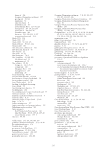Lake Eyre Basin Rivers 162 options. Respondents are presented with a description of a change (e.g. a project to improve the quality of a wetland), and a question is asked to identify their willingness to pay for this change to occur. Respondents evaluate a single scenario, indicating whether they would vote in favour or against it, or how much they would be willing to pay to achieve the scenario. For example, would you vote in a referendum in favour of every householder in New South Wales paying $100 to restore the Macquarie Marshes, a wetland affected by water resource development (see Chapter 16)? Choice modelling has become increasingly popular, particularly in Australia. In choice modelling, the goods and questions are described and asked differently to those in contingent valuation. In choice modelling, respondents evaluate several scenarios, defined using a fixed set of attributes which change across scenarios. For example, this may include changes to the area of native vegetation or number of native fish (Table 18.1). Respondents would then choose between alternatives described, using these features and a household cost. Before making such a choice, they would also receive information about the environmental condition of the river, based on the latest current understanding, what has led to any decline, and what options are available to improve environmental quality. These choices are repeated for individuals several times. The repeated choices provide insight into how respondents’ choices change with different levels of the attributes and household cost. This provides a measure of how much respondents are willing to pay for each attribute. For example, if increasing the frequency of waterbird breeding by a year has the same effect on the probability of people choosing an option as reducing household costs by $20, this indicates that household willingness to pay to increase frequency of waterbird breeding by a year is on average $20. Economic value of rivers and wetlands – the Murray–Darling Basin Wetlands and rivers around the world have considerable economic value, as has been demonstrated using these methods (Brander et al. 2006). In Australia, there is also growing understanding of the economic value of wetlands and rivers of the Murray–Darling Basin (Table 18.2). Table 18.1. Example of choice modelling, comparing different features of river health from the River Murray (based on MacDonald et al. 2011). Respondents could be asked to choose one of the three options (A, B, C), assuming this was their only choice. Features Maintain current (option A) Improve quality of the River Murray and Coorong (option B) Improve quality of the River Murray and Coorong (option C) Waterbird breeding along the River Murray Every 10 years Every seven years Every year Native fish 10% of original population 20% of original population 40% of original population Healthy riverside vegetation 50% of original area 60% of original area 60% of original area Waterbird habitat in the Coorong Poor quality Good quality Poor quality Household cost ($/year for 10 years) $0 $50 $250
Downloaded from CSIRO with access from at 216.73.216.191 on Nov 29, 2025, 5:54 AM. (c) CSIRO Publishing

















































































































































































































































































